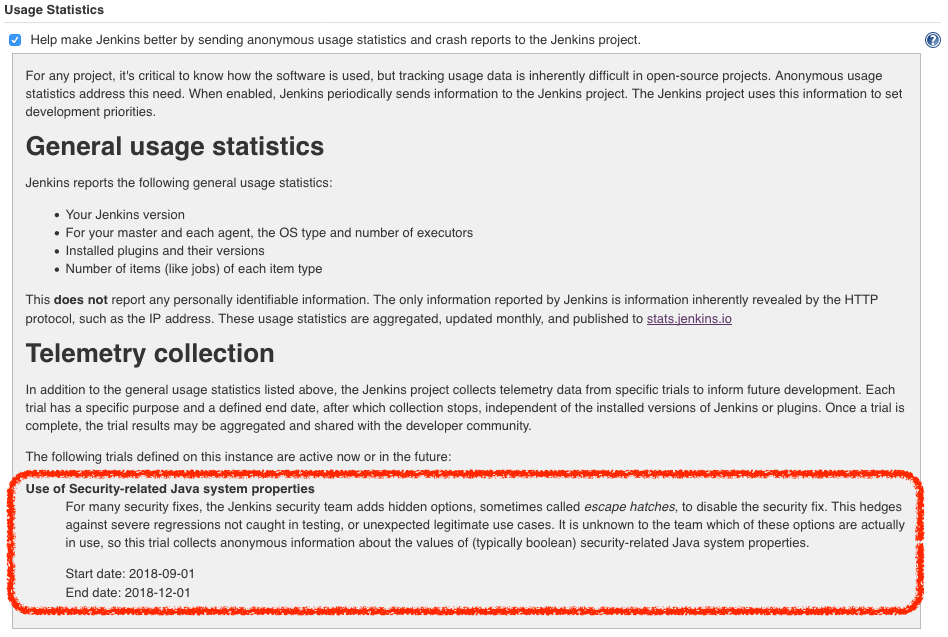Improving Jenkins Release Quality using Uplink Telemetry
One of the major strengths of Jenkins is its customizability and extensibility. With its plugin ecosystem and long list of (possibly hidden) options, Jenkins can be used for a wide range of use cases.
The downside of all this flexibility is that, not knowing how people use Jenkins, we mostly rely on issues filed in our bug tracker to know when things go wrong. And over the years, quite a few things have gone wrong. The worst of these have been security fixes that have had unintended side effects. Unlike regular changes, it’s not really feasible to roll back security fixes, so users have sometimes had to choose between security and functionality. But even changes developed in the open, such as the introduction of JEP-200, haven’t gone as smoothly as we hoped. With big changes in the works, it’s more important than ever for us to have a better idea how Jenkins is used, so that we can deliver major changes safely.
Jenkins Evergreen solves this to some degree by being always connected to the Jenkins project and reporting back telemetry (mostly errors) allowing us to quickly react and provide fixes. But that project is still pretty new, and its goal of being a more standardized Jenkins does not represent the breadth of configurations of the general user base.
Uplink telemetry
So we recently extended the existing, very limited anonymous usage statistics by adding a simple, extensible telemetry reporting client. We’re calling it Uplink telemetry, based on the name of the service it reports its data to. It made its debut in Jenkins 2.143.
Uplink telemetry is designed to collect data in trials, which are defined as:
-
a well defined set of technical data with a specific purpose
-
a start and end date of the collection
Detailed information explaining the scope and purpose of currently active trials is available in the inline help for the usage statistics control in the global configuration.

Of course, opting out of anonymous usage statistics there also disables the submission of Uplink telemetry. And while Uplink trials report a per-instance UUID to help with collation (e.g. removal of duplicate submissions), that UUID is exclusively used for this purpose, and independent of all other properties of an instance. This prevents us from correlating reported data with specific instances. These measures are in place to strike a balance between the need to understand how Jenkins is used and respecting users' privacy.
Improving Jenkins through real-world data
We’re already created our first trial. Jenkins 2.143 includes a trial to gather information about how common it is for instances to use Java system properties to disable (parts of) security fixes. When we publish a security fix and we’re not completely certain it is safe to apply for everyone, we add another of these options — just in case. As you can imagine, quite a few of these hidden options exist. Until now, user feedback in our issue tracker was the only way we could estimate the need for any of these options. With Uplink, Jenkins will report that information to us.
The trial is scheduled to run for the next six weeks, enough to hopefully gather this information from a large number of users of both LTS and weekly releases. Our hope is that we will be able to remove some of these options entirely, as they might not be needed after all. For others, we might need to consider elevating them to supported features, or finding better solutions obviating the need for them.
In the future, I will publish of some of what we have learned from the first trial running through Uplink telemetry. I look forward to Jenkins continuing to improve with real-world data informing our future decisions.